Development of Prediction Model for Damage Costs of Heavy Rainfall Disasters Using Machine Learning in the Republic of Korea
Abstract
1. Introduction
2. Materials and Methods
2.1. Random Forest
2.2. K-Nearest Neighbors
2.3. Decision Tree
2.4. eXtreme Gradient Boosting
2.5. Predictive Power Evaluation Techniques
3. Heavy Rainfall Disaster Status
3.1. Characteristics of Heavy Rainfall Events
3.2. Rainfall Characteristics of Heavy Rainfall Events
4. Results
4.1. Analysis of Machine Waring Models for Heavy Rainfall Enents
4.2. Accurancy Evaluation of Heavy Rainfall Events
5. Discussion
6. Conclusions
Author Contributions
Funding
Data Availability Statement
Acknowledgments
Conflicts of Interest
References
- Agrawala, S. Context and Early Origins of the Intergovernmental Panel on Climate Change. Clim. Change 1998, 39, 605–620. [Google Scholar] [CrossRef]
- Zhang, W.; Villarini, G.; Vecchi, G.A.; Smith, J.A. Urbanization exacerbated the rainfall and flooding caused by hurricane Harvey in Houston. Nature 2018, 563, 384–388. [Google Scholar] [CrossRef] [PubMed]
- Zeleňáková, M.; Fijko, R.; Labant, S.; Weiss, E.; Markovič, G.; Weiss, R. Flood risk modelling of the Slatvinec stream in Kružlov village, Slovakia. J. Clean. Prod. 2019, 212, 109–118. [Google Scholar] [CrossRef]
- Aziz, K.; Rahman, A.; Fang, G.; Shrestha, S. Application of artificial neural networks in regional flood frequency analysis: A case study for Australia. Stoch. Environ. Res. Risk Assess. 2014, 28, 541–554. [Google Scholar] [CrossRef]
- Mekanik, F.; Imteaz, M.A.; Gato-Trinidad, S.; Elmahdi, A. Multiple regression and Artificial Neural Network for long-term rainfall forecasting using large scale climate modes. J. Hydrol. 2013, 503, 11–21. [Google Scholar] [CrossRef]
- Xu, Z.X.; Li, J.Y. Short-term inflow forecasting using an artificial neural network model. Hydrol. Process. 2002, 16, 2423–2439. [Google Scholar] [CrossRef]
- Choi, C.; Park, K.; Park, H.; Lee, M.; Kim, J.; Kim, H.S. Development of Heavy Rain Damage Prediction Function for Public Facility Using Machine Learning. J. Korean Soc. Hazard Mitig. 2017, 17, 443–450. [Google Scholar] [CrossRef]
- Choi, C.; Kim, J.; Kim, J.; Kim, D.; Bae, Y.; Kim, H.S. Development of Heavy Rain Damage Prediction Model Using Machine Learning Based on Big Data. Adv. Meteorol. 2018, 2018, 5024930. [Google Scholar] [CrossRef]
- Wang, W.; Li, J.; Qu, X.; Han, Z.; Liu, P. Prediction on landslide displacement using a new combination model: A case study of Qinglong landslide in China. Nat. Hazards 2019, 96, 1121–1139. [Google Scholar] [CrossRef]
- Zanchetta, A.D.L.; Coulibaly, P. Recent Advances in Real-Time Pluvial Flash Flood Forecasting. Water 2020, 12, 570. [Google Scholar] [CrossRef]
- Rodrigues, M.; de la Riva, J. An insight into machine-learning algorithms to model human-caused wildfire occurrence. Environ. Model. Softw. 2014, 57, 192–201. [Google Scholar] [CrossRef]
- Srivastava, S. On Foveation of Deep Neural Networks. Master’s Thesis, Massachusetts Institute of Technology, Cambridge, MA, USA, 2019. [Google Scholar]
- Jaafari, A.; Zenner, E.K.; Panahi, M.; Shahabi, H. Hybrid artificial intelligence models based on a neuro-fuzzy system and metaheuristic optimization algorithms for spatial prediction of wildfire probability. Agric. For. Meteorol. 2019, 266–267, 198–207. [Google Scholar] [CrossRef]
- Mann, M.L.; Warner, J.M.; Malik, A.S. Predicting high-magnitude, low-frequency crop losses using machine learning: An application to cereal crops in Ethiopia. Clim. Change 2019, 154, 211–227. [Google Scholar] [CrossRef]
- Haggag, M.; Siam, A.S.; El-Dakhakhni, W.; Coulibaly, P.; Hassini, E. A deep learning model for predicting climate-induced disasters. Nat. Hazards 2021, 107, 1009–1034. [Google Scholar] [CrossRef]
- Cholissodin, I.; Sutrisno, S. Prediction of Rainfall using Simplified Deep Learning based Extreme Learning Machines. J. Inf. Technol. Comput. Sci. 2018, 3, 120–131. [Google Scholar] [CrossRef]
- Tien Bui, D.; Hoang, N.-D.; Martínez-Álvarez, F.; Ngo, P.-T.T.; Hoa, P.V.; Pham, T.D.; Samui, P.; Costache, R. A novel deep learning neural network approach for predicting flash flood susceptibility: A case study at a high frequency tropical storm area. Sci. Total Environ. 2020, 701, 134413. [Google Scholar] [CrossRef] [PubMed]
- Ganguly, K.K.; Nahar, N.; Hossain, B.M.M. A machine learning-based prediction and analysis of flood affected households: A case study of floods in Bangladesh. Int. J. Disaster Risk Reduct. 2019, 34, 283–294. [Google Scholar] [CrossRef]
- Appiah-Badu, N.K.A.; Missah, Y.M.; Amekudzi, L.K.; Ussiph, N.; Frimpong, T.; Ahene, E. Rainfall Prediction Using Machine Learning Algorithms for the Various Ecological Zones of Ghana. IEEE Access 2022, 10, 5069–5082. [Google Scholar] [CrossRef]
- Mohd, R.; Ahmed Butt, M.; Baba, M.Z. Comparative Study of Rainfall Prediction Modeling Techniques (A Case Study on Srinagar, J&K, India). Asian J. Comput. Sci. Technol. 2018, 7, 13–19. [Google Scholar] [CrossRef]
- Balram, G.; Poornachandrarao, N.; Ganesh, D.; Nagesh, B.; Basi, R.A.; Kumar, M.S. Application of Machine Learning Techniques for Heavy Rainfall Prediction using Satellite Data. In Proceedings of the 2024 5th International Conference on Smart Electronics and Communication (ICOSEC), Trichy, India, 18–20 September 2024; pp. 1081–1087. [Google Scholar]
- Yuan, X.; Zhang, X.-C.; Wang, X.-G.; Zhang, Y. Flood disaster monitoring based on Sentinel-1 data: A case study of Sihu Basin and Huaibei Plain, China. Water Sci. Eng. 2021, 14, 87–96. [Google Scholar] [CrossRef]
- Jongman, B.; Wagemaker, J.; Romero, B.R.; De Perez, E.C. Early Flood Detection for Rapid Humanitarian Response: Harnessing Near Real-Time Satellite and Twitter Signals. ISPRS Int. J. Geo-Inf. 2015, 4, 2246–2266. [Google Scholar] [CrossRef]
- Feng, Y.; Sester, M. Extraction of Pluvial Flood Relevant Volunteered Geographic Information (VGI) by Deep Learning from User Generated Texts and Photos. ISPRS Int. J. Geo-Inf. 2018, 7, 39. [Google Scholar] [CrossRef]
- Picon, A.; Alvarez-Gila, A.; Irusta, U.; Echazarra, J. Why deep learning performs better than classical machine learning. Dyna Ing. Ind. 2020, 95, 119–122. [Google Scholar]
- Bai, H.; Yu, H.; Yu, G.; Huang, X. A novel emergency situation awareness machine learning approach to assess flood disaster risk based on Chinese Weibo. Neural Comput. Appl. 2022, 34, 8431–8446. [Google Scholar] [CrossRef]
- Lai, C.; Chen, X.; Zhao, S.; Wang, Z.; Wu, X. A flood risk assessment model based on random forest and its application. J. Hydraul. Eng. 2015, 46, 58–66. [Google Scholar]
- Feng, Q.; Liu, J.; Gong, J. Urban Flood Mapping Based on Unmanned Aerial Vehicle Remote Sensing and Random Forest Classifier—A Case of Yuyao, China. Water 2015, 7, 1437. [Google Scholar] [CrossRef]
- Liu, Y.; Lu, X.; Yao, Y.; Wang, N.; Guo, Y.; Ji, C.; Xu, J. Mapping the risk zoning of storm flood disaster based on heterogeneous data and a machine learning algorithm in Xinjiang, China. J. Flood Risk Manag. 2021, 14, e12671. [Google Scholar] [CrossRef]
- Liu, H.; Hao, Y.; Zhang, W.; Zhang, H.; Gao, F.; Tong, J. Online urban-waterlogging monitoring based on a recurrent neural network for classification of microblogging text. Nat. Hazards Earth Syst. Sci. 2021, 21, 1179–1194. [Google Scholar] [CrossRef]
- Avand, M.; Moradi, H.; Lasboyee, M.R. Using machine learning models, remote sensing, and GIS to investigate the effects of changing climates and land uses on flood probability. J. Hydrol. 2021, 595, 125663. [Google Scholar] [CrossRef]
- Wu, Z.; Shen, Y.; Wang, H.; Wu, M. Urban flood disaster risk evaluation based on ontology and Bayesian Network. J. Hydrol. 2020, 583, 124596. [Google Scholar] [CrossRef]
- Jiang, Z.; Yang, S.; Liu, Z.; Xu, Y.; Xiong, Y.; Qi, S.; Pang, Q.; Xu, J.; Liu, F.; Xu, T. Coupling machine learning and weather forecast to predict farmland flood disaster: A case study in Yangtze River basin. Environ. Model. Softw. 2022, 155, 105436. [Google Scholar] [CrossRef]
- Fitriyaningsih, I.; Basani, Y. Prediksi Kejadian Banjir dengan Ensemble Machine Learning Menggunakan BP-NN dan SVM. J. Teknol. Dan Sist. Komput. 2019, 7, 93–97. [Google Scholar] [CrossRef]
- Wahyono, I.D.; Asfani, K.; Aripriharta; Fadlika, I.; Jong, G.J. New Method of Artificial Intelligence for Disaster Information Floods use Distributed Wireless Sensors. In Proceedings of the 2019 International Seminar on Application for Technology of Information and Communication (iSemantic), Semarang, Indonesia, 21–22 September 2019; pp. 1–5. [Google Scholar]
- Riza, H.; Santoso, E.W.; Tejakusuma, I.G.; Prawiradisastra, F. Advancing Flood Disaster Mitigation in Indonesia Using Machine Learning Methods. In Proceedings of the 2020 International Conference on ICT for Smart Society (ICISS), Bandung, Indonesia, 19–20 November 2020; pp. 1–4. [Google Scholar]
- Keum, H.J.; Han, K.Y.; Kim, H.I. Real-Time Flood Disaster Prediction System by Applying Machine Learning Technique. KSCE J. Civ. Eng. 2020, 24, 2835–2848. [Google Scholar] [CrossRef]
- Zhu, H.; Leandro, J.; Lin, Q. Optimization of Artificial Neural Network (ANN) for Maximum Flood Inundation Forecasts. Water 2021, 13, 2252. [Google Scholar] [CrossRef]
- Tehrany, M.S.; Pradhan, B.; Mansor, S.; Ahmad, N. Flood susceptibility assessment using GIS-based support vector machine model with different kernel types. Catena 2015, 125, 91–101. [Google Scholar] [CrossRef]
- Wang, Z.; Lai, C.; Chen, X.; Yang, B.; Zhao, S.; Bai, X. Flood hazard risk assessment model based on random forest. J. Hydrol. 2015, 527, 1130–1141. [Google Scholar] [CrossRef]
- Al-Juaidi, A.E.M.; Nassar, A.M.; Al-Juaidi, O.E.M. Evaluation of flood susceptibility mapping using logistic regression and GIS conditioning factors. Arab. J. Geosci. 2018, 11, 765. [Google Scholar] [CrossRef]
- Ma, M.; Zhao, G.; He, B.; Li, Q.; Dong, H.; Wang, S.; Wang, Z. XGBoost-based method for flash flood risk assessment. J. Hydrol. 2021, 598, 126382. [Google Scholar] [CrossRef]
- Ying, X. An Overview of Overfitting and its Solutions. J. Phys. Conf. Ser. 2019, 1168, 022022. [Google Scholar] [CrossRef]
- Breiman, L. Random Forests. Mach. Learn. 2001, 45, 5–32. [Google Scholar] [CrossRef]
- Liaw, A.; Wiener, M. Classification and regression by randomForest. R News 2002, 2, 18–22. [Google Scholar]
- Amit, Y.; Geman, D. Shape Quantization and Recognition with Randomized Trees. Neural Comput. 1997, 9, 1545–1588. [Google Scholar] [CrossRef]
- Tin Kam, H. The random subspace method for constructing decision forests. IEEE Trans. Pattern Anal. Mach. Intell. 1998, 20, 832–844. [Google Scholar] [CrossRef]
- Liu, S.; Zhang, Z. A multi-stage prediction KNN algorithm based on center vector. Comput. Eng. Sci. 2017, 39, 1758–1764. [Google Scholar]
- Zhang, S.; Li, X.; Zong, M.; Zhu, X.; Cheng, D. Learning k for kNN Classification. ACM Trans. Intell. Syst. Technol. 2017, 8, 43. [Google Scholar] [CrossRef]
- Cover, T.; Hart, P. Nearest neighbor pattern classification. IEEE Trans. Inf. Theory 1967, 13, 21–27. [Google Scholar] [CrossRef]
- Harrington, P. Machine Learning in Action; Manning Publications: Shelter Island, NY, USA, 2012. [Google Scholar]
- Gu, W.; Foster, K.; Shang, J.; Wei, L. A game-predicting expert system using big data and machine learning. Expert Syst. Appl. 2019, 130, 293–305. [Google Scholar] [CrossRef]
- Imandoust, S.B.; Bolandraftar, M. Application of k-nearest neighbor (knn) approach for predicting economic events: Theoretical background. Int. J. Eng. Res. Appl. 2013, 3, 605–610. [Google Scholar]
- Alonso, R.P.; Babac, M.B. Machine learning approach to predicting a basketball game outcome. Int. J. Data Sci. 2022, 7, 60–77. [Google Scholar] [CrossRef]
- Horvat, T.; Havaš, L.; Srpak, D. The Impact of Selecting a Validation Method in Machine Learning on Predicting Basketball Game Outcomes. Symmetry 2020, 12, 431. [Google Scholar] [CrossRef]
- Quinlan, J.R. Simplifying decision trees. Int. J. Man-Mach. Stud. 1987, 27, 221–234. [Google Scholar] [CrossRef]
- Breiman, L.; Friedman, J.; Olshen, R.; Stone, C. Classification and Regression Trees; CRC Press: Boca Raton, FL, USA, 1984. [Google Scholar]
- Kass, G.V. An Exploratory Technique for Investigating Large Quantities of Categorical Data. J. R. Stat. Soc. Ser. C (Appl. Stat.) 1980, 29, 119–127. [Google Scholar] [CrossRef]
- Quinlan, J.R. Induction of decision trees. Mach. Learn. 1986, 1, 81–106. [Google Scholar] [CrossRef]
- Chawla, N.V.; Bowyer, K.W.; Hall, L.O.; Kegelmeyer, W.P. SMOTE: Synthetic minority over-sampling technique. J. Artif. Intell. Res. 2002, 16, 321–357. [Google Scholar]
- Han, H.; Wang, W.-Y.; Mao, B.-H. Borderline-SMOTE: A New Over-Sampling Method in Imbalanced Data Sets Learning. In Proceedings of the Advances in Intelligent Computing, Hefei, China, 23–26 August 2005; Springer: Berlin/Heidelberg, Germany, 2005; pp. 878–887. [Google Scholar]

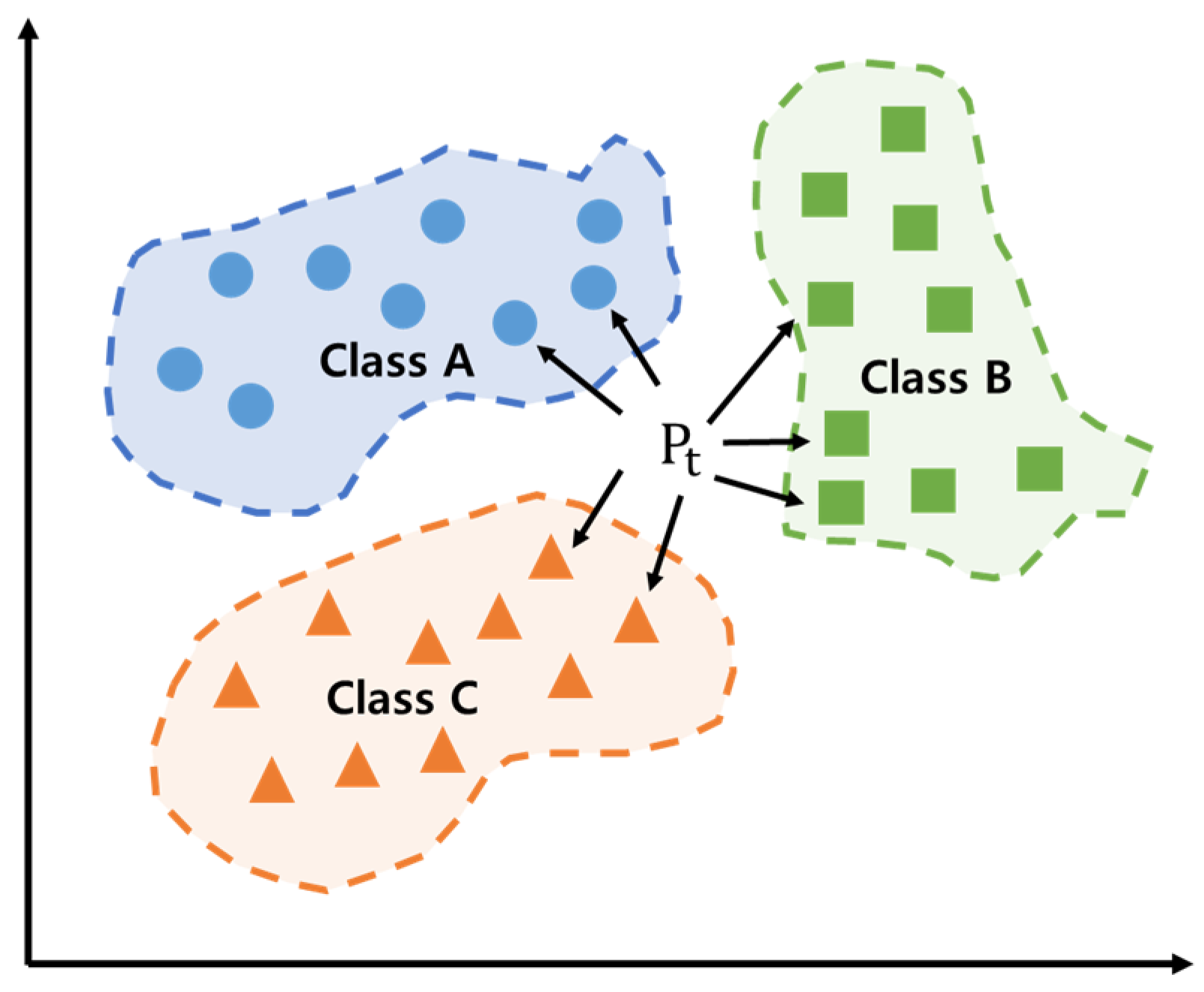
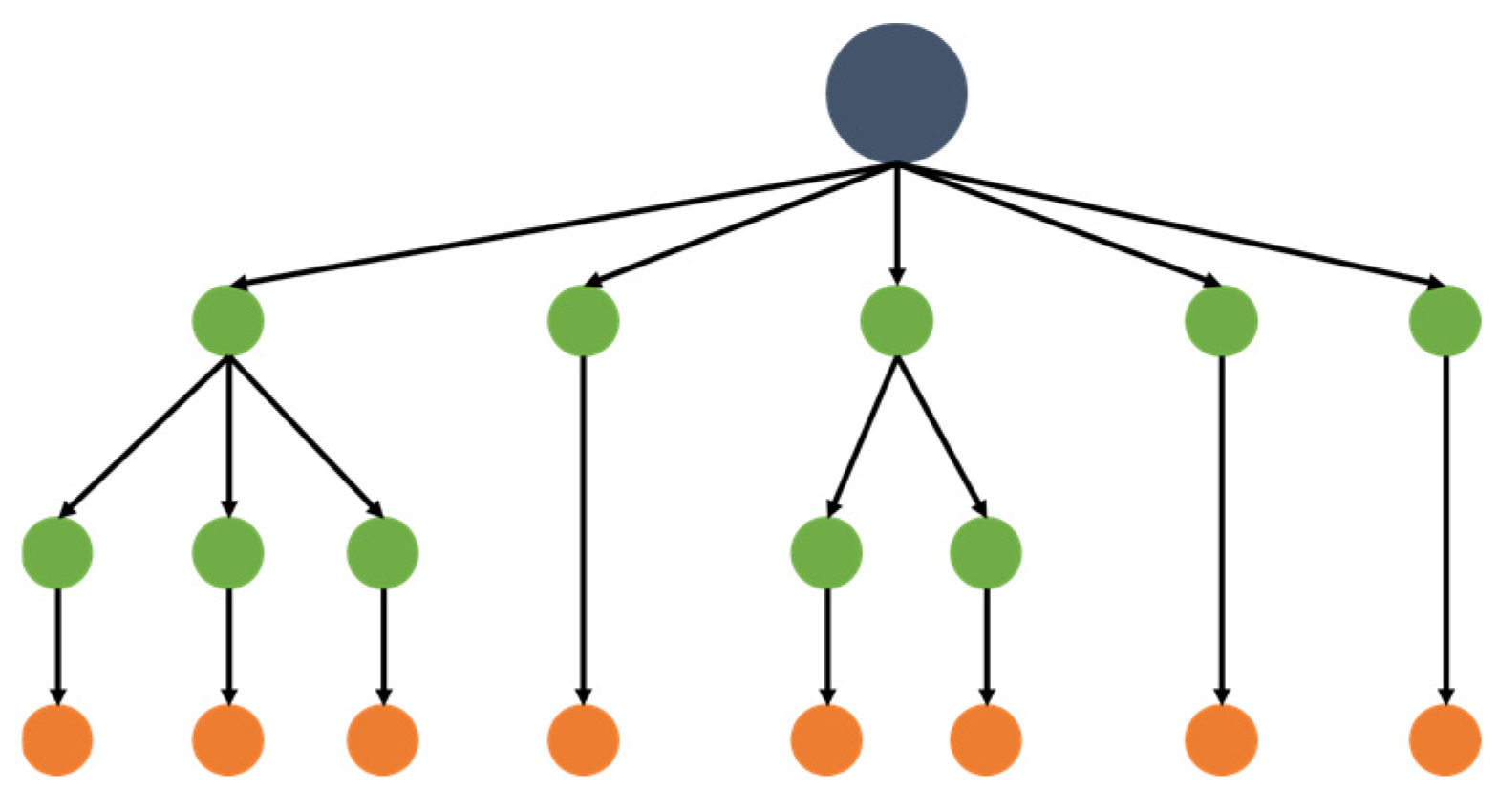


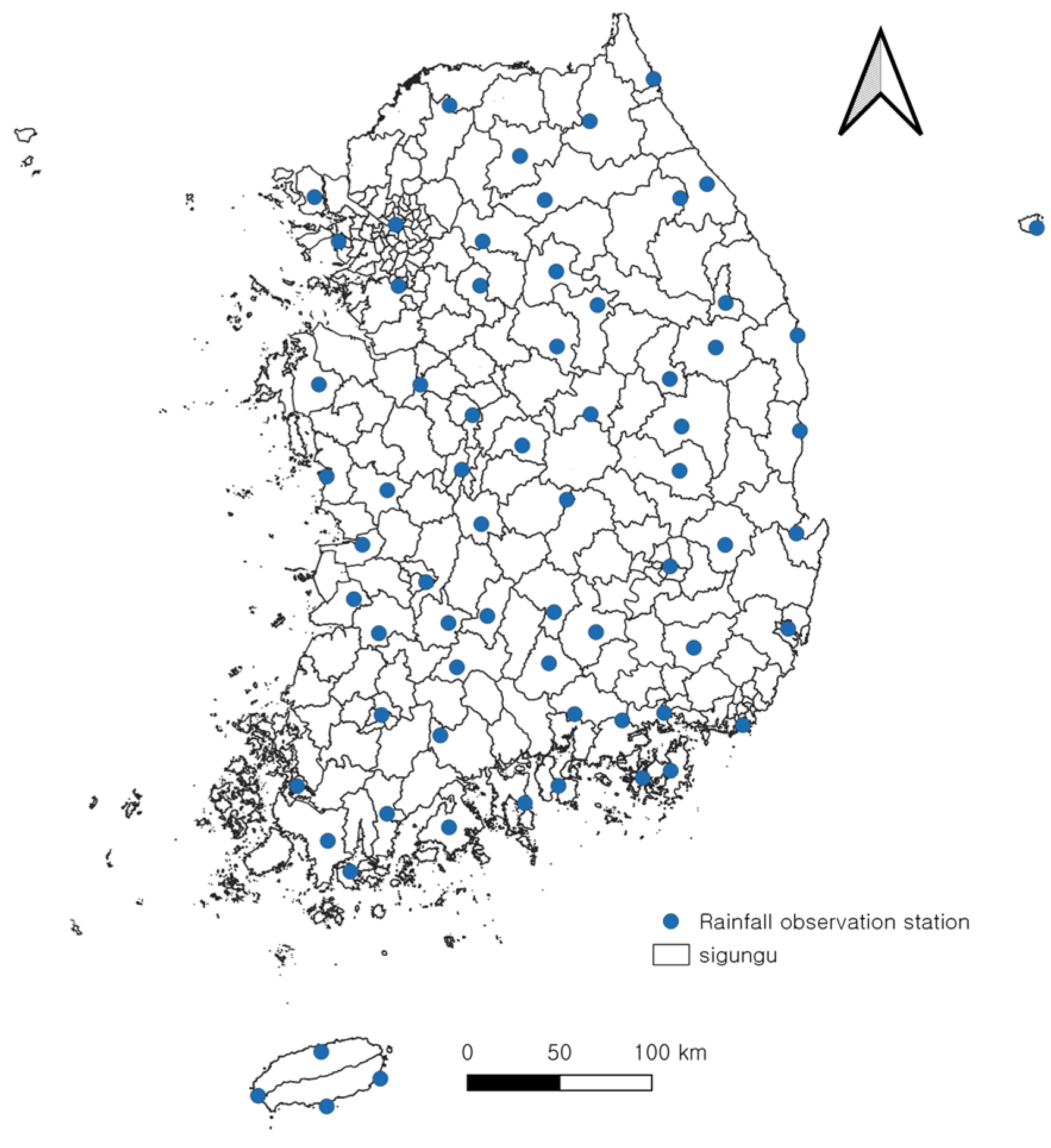

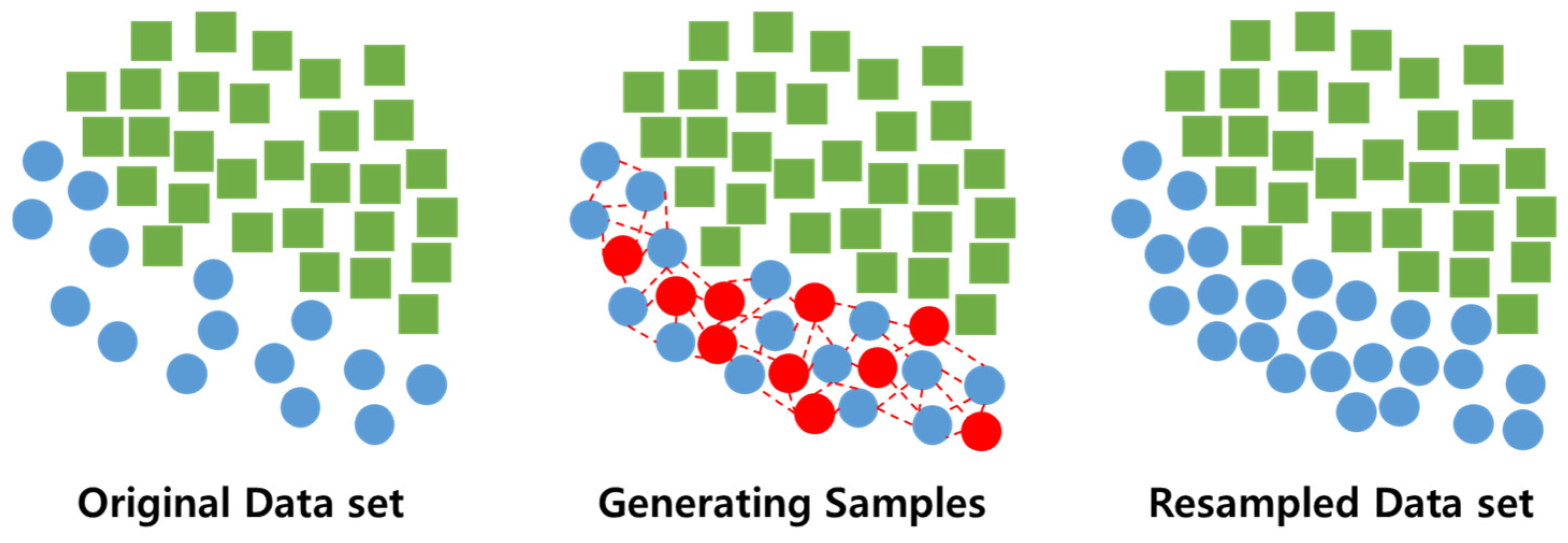
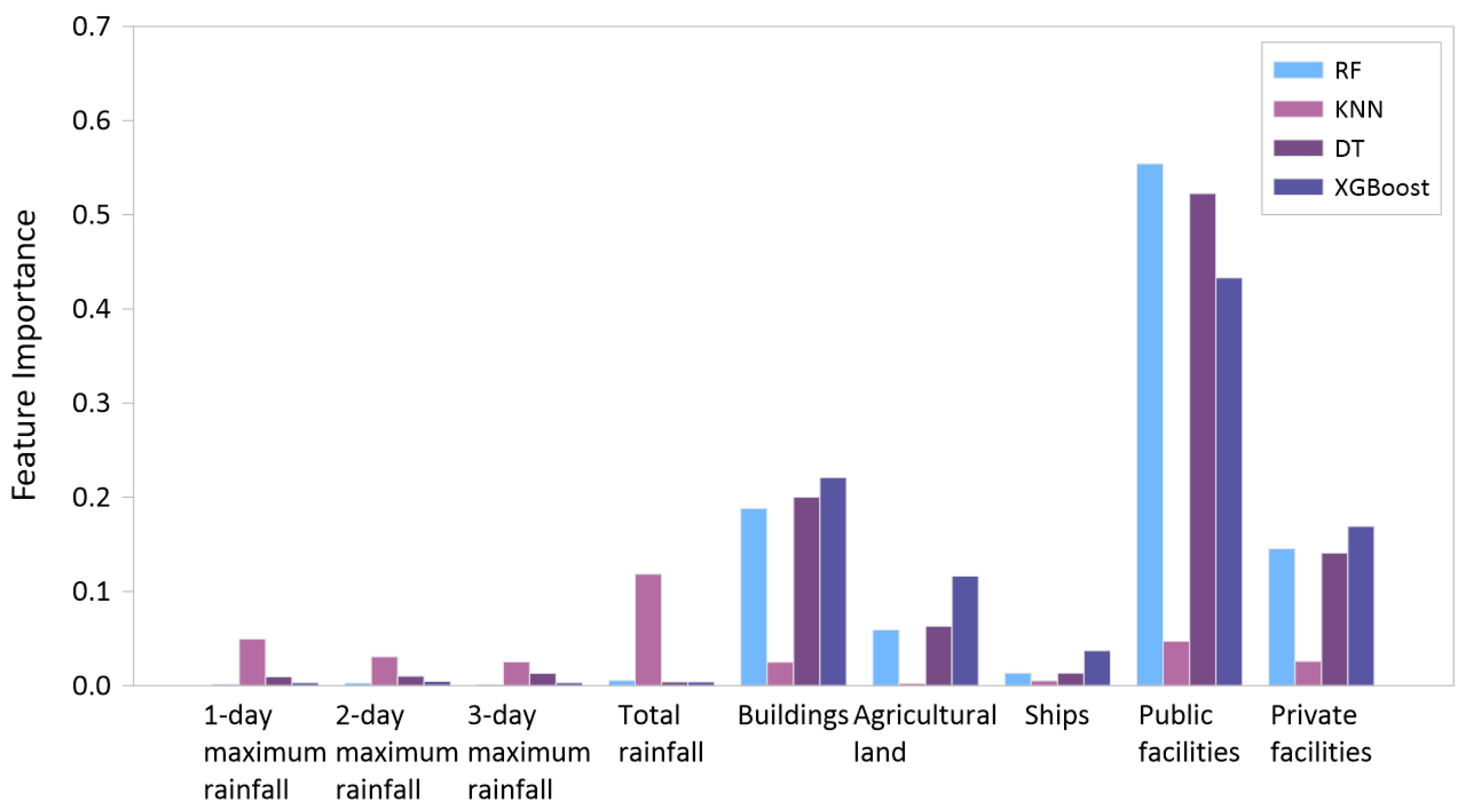

| Table of Contents | Natural Disasters | Heavy Rainfall Disaster |
|---|---|---|
| Disaster type | 8 types | Heavy rainfall, typhoon |
| Affected area (administrative districts) | 9114 | 6902 |
| Damage costs (billions KRW) | 21,734 | 19,093 |
| Configure | Average (millions KRW) | Maximum (millions KRW) | Minimum (millions KRW) | Standard Deviation (millions KRW) |
|---|---|---|---|---|
| Buildings | 1291 | 26,879 | 0 | 2823 |
| Vessel | 189 | 8952 | 0 | 793 |
| Farmland | 2956 | 113,023 | 0 | 11,693 |
| Public utilities | 34,295 | 539,255 | 40,312 | 70,130 |
| Private facilities | 8195 | 174,088 | 0 | 21,969 |
| Total damage costs | 45,398 | 806,435 | 40,312 | 92,019 |
| Configure | Maximum Daily Rainfall | 2-Day Maximum Rainfall | 3-Day Maximum Rainfall | Total Rainfall |
|---|---|---|---|---|
| Average (mm) | 271 | 374 | 427 | 454 |
| Max (mm) | 795 | 816 | 832 | 832 |
| Min (mm) | 114 | 134 | 149 | 220 |
| Standard deviation (mm) | 68 | 89 | 113 | 122 |
| Configure | Study Sections | Evaluation Intervals |
|---|---|---|
| Duration | 1999–2015 | 2016–2019 |
| Rainfall History | 158 | 54 |
| Municipalities | 5698 | 1204 |
| Model | RF, KNN, DT, XGBoost | |
| Dependent Variable | Total damage costs | |
| Independent Variables | Rainfall (1-day maximum rainfall, 2-day maximum rainfall, 3-day maximum rainfall, total rainfall), amount of (buildings, vessels, agricultural land, public facilities, private facilities) | |
| Independent Variables | Feature Importance | |||
|---|---|---|---|---|
| RF | KNN | DT | XGBoost | |
| 1-day maximum rainfall | 0.002 | 0.049 | 0.009 | 0.003 |
| 2-day maximum rainfall | 0.003 | 0.031 | 0.010 | 0.005 |
| 3-day maximum rainfall | 0.001 | 0.025 | 0.013 | 0.003 |
| Total rainfall | 0.005 | 0.118 | 0.004 | 0.004 |
| Buildings | 0.188 | 0.025 | 0.200 | 0.221 |
| Agricultural land | 0.059 | 0.002 | 0.063 | 0.116 |
| Ships | 0.013 | 0.005 | 0.013 | 0.037 |
| Public facilities | 0.554 | 0.047 | 0.523 | 0.433 |
| Private facilities | 0.145 | 0.026 | 0.141 | 0.169 |
| Model | EVS | MAPE | |
|---|---|---|---|
| RF | 0.9522 | 0.9523 | 0.0542 |
| KNN | 0.6547 | 0.6685 | 0.3112 |
| DT | 0.8759 | 0.8759 | 0.0689 |
| XGBoost | 0.7379 | 0.7381 | 0.1359 |
| Model | F-Statistic | p-Value |
|---|---|---|
| 20.03 | 4.46 × 10−4 | |
| EVS | 445.48 | 3.08 × 10−9 |
| MAPE | 360.39 | 7.14 × 10−9 |
Disclaimer/Publisher’s Note: The statements, opinions and data contained in all publications are solely those of the individual author(s) and contributor(s) and not of MDPI and/or the editor(s). MDPI and/or the editor(s) disclaim responsibility for any injury to people or property resulting from any ideas, methods, instructions or products referred to in the content. |
© 2025 by the authors. Licensee MDPI, Basel, Switzerland. This article is an open access article distributed under the terms and conditions of the Creative Commons Attribution (CC BY) license (https://creativecommons.org/licenses/by/4.0/).
Share and Cite
Song, Y.; Song, Y.H.; Park, M.; Kim, S.Y. Development of Prediction Model for Damage Costs of Heavy Rainfall Disasters Using Machine Learning in the Republic of Korea. Climate 2025, 13, 72. https://doi.org/10.3390/cli13040072
Song Y, Song YH, Park M, Kim SY. Development of Prediction Model for Damage Costs of Heavy Rainfall Disasters Using Machine Learning in the Republic of Korea. Climate. 2025; 13(4):72. https://doi.org/10.3390/cli13040072
Chicago/Turabian StyleSong, Youngseok, Yang Ho Song, Moojong Park, and Sang Yeob Kim. 2025. "Development of Prediction Model for Damage Costs of Heavy Rainfall Disasters Using Machine Learning in the Republic of Korea" Climate 13, no. 4: 72. https://doi.org/10.3390/cli13040072
APA StyleSong, Y., Song, Y. H., Park, M., & Kim, S. Y. (2025). Development of Prediction Model for Damage Costs of Heavy Rainfall Disasters Using Machine Learning in the Republic of Korea. Climate, 13(4), 72. https://doi.org/10.3390/cli13040072







